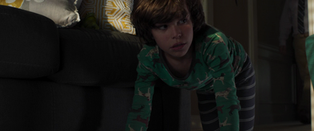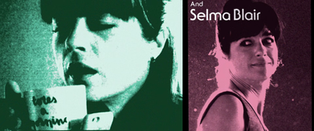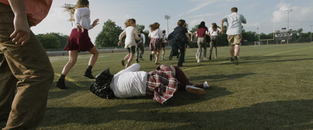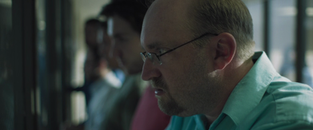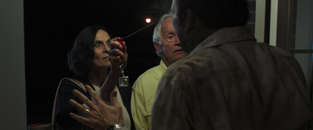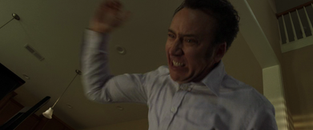Mom and Dad (2017)
- nickkarner
- Apr 20, 2023
- 10 min read

Taboo subject matter has always held a certain fascination for me. The more daring, the better. This may be the reason why I regard Todd Solondz’s Happiness (1998) as my favorite film. Many films are more entertaining - although as a dark, perverse comedy, Happiness has few equals - but the real reason why Solondz’s exploration of a group of deeply dysfunctional and disturbed individuals is so effective is his willingness to quote: "Go there." The entire ensemble is top-notch, with Jane Adams and Philip Seymour Hoffman being stand-outs, but the most brilliant and complex performance belongs to Dylan Baker, playing a friendly neighborhood pedophile and rapist. I’d never seen a film depict this sort of depravity with such elegance and even compassion for such a sick individual. As the film industry relaxed its boundaries more and more over the years, particularly with the advent of streaming, which had the unexpected benefit of allowing filmmakers to bypass the dreaded MPAA, taboos were slowly broken. Silly ones like a toilet flushing in Psycho or inter-racial couples should’ve been banished long before they eventually were, but subjects like incest, drug addiction, bestiality, necrophilia, and many more weren’t often portrayed onscreen without being heavily compromised. The death of children has always been a particularly tricky subject to handle. There have been countless films depicting the death of a child, but oftentimes it’s done offscreen or happened long before the events of the film take place. This is a generalization and there are so many other possibilities.

Atom Egoyan’s Oscar-nominated The Sweet Hereafter (1997) attempts to understand the aftermath of a horrible accident which resulted in the death of a busload of kids. John Carpenter’s Assault on Precinct 13’s (1976) infamous “vanilla twist” scene still packs a wallop to this day not only for its shockingly abrupt death but for the simple fact that a sweet little girl is the victim of a brutal murder. Films that depict evil children like The Omen, The Bad Seed, Orphan, and The Good Son are basically given a pass to murder these terrible kids (or in Orphan’s case, little person) outright. Then there’s Narciso Ibañez Serrador’s stunning 1976 horror-thriller Who Can Kill a Child?. Its relatively simple plot revolves around island children who’ve inexplicably gone mad and murder any adult they come in contact with. Think Children of the Corn only...you know, good.

Writer/Director Brian Taylor’s all-style, very little substance Mom and Dad (2017) attempts the inverse of Serrador’s film. This time, it’s the parents who’ve gone mad and lash out at their children. There are some allusions as to the cause; a mysterious static signal on television, but regardless, M & D (not to be confused with the infamous 1945 “educational” film Mom and Dad) attempts to “go there,” with varying results.
Taylor’s hyperactive style, honed in his work with Mark Neveldine on the Crank films, Gamer, and Ghost Rider: Spirit of Vengeance, certainly keeps things moving at a steady pace. The featurette for Ghost Rider: SOV was highly impressive as the filmmakers were going for a more physical, wild shooting style rather than a flat, static attempt to capture chase scenes. While Ghost Rider still didn’t end up being anything more than an empty, flashy exercise in style, it showed the two have a talent for masking shallow characterizations and threadbare plotlines with flamboyant camera work and editing. Their collaboration with Nicolas Cage on Ghost Rider likely served as a catalyst for the Oscar-winning actor to sign on for Mom and Dad. Then again, Cage probably would’ve signed on for it anyways, knowing the way he operates.

There's much to be said about Cage and his career. The transition from a talented, quirky hunk who happened to be a part of Hollywood royalty, into a respected, award-winning actor, then an action star, and finally, to a parody of himself has been an alternatingly fascinating and depressing spectacle to behold. Despite the countless number of knock-offs and DTV films, the period between 2017 and 2019 provided something of a resurgence and a reminder of how much fun it can be to watch Cage do his thing. Mom and Dad turned enough heads when the idea of Cage and the always-reliable and underrated Selma Blair (Storytelling) playing homicidal parental units hellbent on murdering their kids was put out there. This was followed up by SpectreVision’s production of Panos Cosmatos’ hugely popular Mandy, a gorgeous and very trippy revenge flick which was a satisfying mix of moody filmmaking and watching Nic Cage go “full-Cage.” Clever and knowing voice-work in both Teen Titans GO! to the Movies and Spider-Man: Into the Spider-Verse “I like drinking egg creams and punching Nazis. A lot” helped solidify something of a comeback for Cage, which led to his working with SpectreVision again on the expectedly triumphant return of cult director Richard Stanley for the H.P. Lovecraft adaptation, Color Out of Space. Sadly, this film was a major disappointment due to the poor dialogue and Cage’s even worse acting decisions. His performance actually derails the film despite his presence being a major selling point. A decision to resurrect his infamous Peter Loew voice from Vampire’s Kiss was a shockingly bad decision that doesn’t pay off. Although he’ll continue to make films, both terrible and perhaps not-so-terrible, this suddenly fruitful period continues to have its ups and downs.

Running at a svelte 82 minutes, Taylor injects an admirable dose of media reportage into the proceedings, although their blanket statements do come off as too well-informed considering how suddenly the attacks begin. This is supposedly a nation-wide epidemic and the use of news footage does give the film some scope, but it’s obvious that the budget was far too meager to truly realize the epic tale this movie could’ve told. I’m reminded of the crappy Cannon production Invasion U.S.A. (1985). It’s a film with an intriguing premise that might’ve succeeded with a healthier budget. Here, what could either have been a phenomenal 30-minute short or at least a feature which cast its net much wider is squandered by the need to cut away to lengthy flashbacks, delaying the inevitable melee. The concept is there, but the execution is hindered by outside forces.

That’s not to say the film doesn’t have a great deal to offer as far as thrills go. It’s a black comedy with a goofily nasty streak. “Fuck” is thrown around with great abandon in front of the children and its portrait of two people, Cage and Blair, venting their frustrations and living out their mid-life crises by killing their kids is explored with both humor and even some depth. The chemistry between Blair and Cage, as well as the twisting of audience sympathy due to their determination in exterminating their children is quite strong. They bicker, reconcile, and even become tender with each other as they attempt to suffocate daughter Carly (Anne Winters, 13 Reasons Why) and son Josh (Zackary Arthur, Transparent) by running a gas line into the basement where the kids have barricaded themselves. The escalating tension caused by the alarming number of parents congregating around their children’s school strengthens the film’s power and attraction. Once the chaos begins, the kinetic style of the editing and cinematography work in tandem with the overall gonzo nature of the movie.
Brian Taylor’s intention to create a 70’s style, no-holds-barred film is evident right from the start, after a brief scene of a mother leaving her baby to get hit by an on-coming train. A stylish and whimsically old-school credits sequence, complete with era-appropriate font, helpfully shows us all of the characters. The film opens as most nonsense movies do, with children having plenty of time in the morning to get up, hang out, have breakfast with their parents, and then head off to school with no worries about being late. When I went to high school, I’d be lucky if the sun was just peaking over the horizon by the time I got to school. Josh inexplicably stays home while Carly goes to school, having stolen cash out of her mother’s wallet to buy drugs with. Their maid/cook Sun-Yi (Sharon Gee, Oldboy, Bill & Ted Face the Music) loses it quite early and beats her daughter to death. Offscreen, of course.
Of course, you might ask? Yes, that’s due to the fact that this film believes it’s being edgy, and maybe in a small way, it is, but 90% of the child deaths occur offscreen. Do I believe it would be distasteful to actually depict kids being bludgeoned and stabbed onscreen? Absolutely, but the fact is, I paid to watch Mom and Dad, so I’m going in expecting to see that. Instead, the film repeatedly wimps out. It’s a tricky question “too much vs. too little.” If there was too much bloodshed, then the film would be unreleaseable, but as it is, it doesn’t have nearly enough carnage to satisfy a group of horror fans who expect buckets of blood from such a wild story. The frantic camera work, courtesy of legendary cinematographer Daniel Pearl (the original Texas Chainsaw Massacre, basically every music video you can imagine) is cut together with a jumbled precision by Taylor/Neveldine’s regular editor Fernando Villena and Rose Corr. The main problem with the film is its inconsistency.
The static on the television clearly seems to be the reason parents change from loving caregivers to homicidal maniacs, with an underlying indication that there are deep-seated resentment issues due to a “dreams deferred” mindset. And yet we get no real answer as to why and when the impairment starts. This was an intentional step Taylor took, indicating that he simply wanted to make a B-movie, but inserting little red herrings and supposed clues doesn’t help. Selma Blair takes a great deal of time to go through the change while literally everyone around her seems to already have been affected. Blair’s work here is exemplary as a mother who feels her daughter wants nothing to do with her and a general malaise stemming from her lack of a career or prospects outside of being a homemaker. Speaking of which, I take major umbrage with the fact that Cage claims to have gone from a “145,000 salary to $45,000” and Blair appears to be a housewife. Why would they need or be able to afford a maid/cook? Doesn’t make any sense.
The chaos that occurs once the killings begin have a “zero to sixty” vibe that feels rushed, especially in the school release sequence.
The best scenes are those that actually realize and delve deeper into Taylor’s concept. Maybe the most infamous scene features Blair and her sister’s newborn baby. As Roxette’s “It Must Have Been Love” plays, her sister attempts to crush the child and the doctors and Blair desperately try to snatch the child away from her. She very nearly slices it open with a scalpel. I’m glad the baby wasn’t killed, although I could see another filmmaker letting it happen. A later scene featuring parents staring menacingly behind the glass display case at the rows of newborn babies is quite funny. The fact that parents only target their own children is an intriguing thought behind the genetics of the ailment. When Carly’s best friend is strangled to death by her vain, fading trophy wife mother, the woman looks up and smiles sweetly at a horrified Carly.
The best and most enjoyable twist arrives when Cage’s parents arrive for dinner. Thus far, the film has only kept an “adults versus children/teens” theme, but it turns out the problem is multi-generational. Cage is maced by his mother (Marilyn Dodds Frank, High Fidelity) and stabbed repeatedly by his father (the great Lance Henriksen, Aliens, The Terminator). This scene follows an extended sequence where Cage and Blair have managed to get their children out of the basement and are preparing to annihilate them with a mechanical saw and a meat tenderizer. It’s annoying that they have any real dialogue between them since all of the other children and their parents rarely spoke, but one must pad the running time. Things go particularly berserk as Cage chases his son and Henriksen chases Cage. Everything culminates with Cage and Blair being captured and tied to a pole in the basement. The film ends abruptly with Cage being cut off mid-dialogue, but in the Spanish version, the final line is revealed to be “but sometimes we just want to KILL YOU!”
How did Blair and Cage end up getting defeated? Great question! With Cage, he gets hit by a car, so that’s fine. However, Carly’s presumably indestructible boyfriend Damon (Robert T. Cunningham) comes to her rescue and bashes Blair in the face with a shovel. How this occurs, I have no idea. Know why? Because prior to this, he’s slashed by his dad, who them clumsily impales himself on his own broken bottle. Next, Cage slams him into the floor, knocking him unconscious for hours until the movie needs him to wake back up. He gets hit again and falls from a second story loft. Earlier, I’d thought he was dead due to his inability to wake up after such an extended period. He’d almost certainly suffer brain damage from a concussion, but the fall over the staircase should've been enough to finish him off. Yet, there he is, all set to deliver the finishing blow. Another problem is the overall racist portrayal of the character. While all of the white people live in unbelievably huge houses, he lives in a tiny house with overgrown weeds snaking along the chain-link fence. When Cage returns home and finds Damon there, it makes zero sense that Cage would be so hostile to him because all of the other parents have acted normally toward anyone who isn’t their child. It’s bizarre and nonsensical.
In the end, the film is let down by a surprisingly low-level of gore and plotting. The major set piece of the film is a massive raid by the parents in which they attack. The chaos that occurs once the killings begin have a “zero to sixty” vibe that feels rushed, especially in the school release sequence. Police are already there, the students are weirded out, but still, no one really knows what’s going on until it’s too late. One gouges their child with her keys; another attempts to suffocate a teen with a garbage bag. But instead of showing teen after teen getting murdered, we instead get cops beating up the parents. The film refuses to follow-up on the promise of boatloads of dead kids. It’s still relatively exciting and if the entire film featured this kind of mayhem interspersed with a stronger plotline, it might’ve been a black comedy for the ages.










